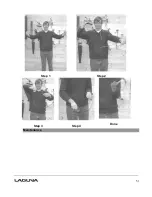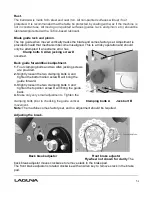
46
that listed below, which is a good general selection and will allow you to tackle most jobs. As
you gain experience, you will settle on the blades that suit you.
1.
1/4" 6 TPI. This is a small, aggressive blade that is suitable for tight curves and fast
cutting where a good surface finish of the cut is not important.
2.
1/4" 14 TPI. This is a small, fine blade suitable for reasonably tight cuts where the
surface finish is important, but speed of cut is less important.
3.
1/2" 3 TPI. This is a general-purpose blade that can cut large radiuses and short
sections of straight cuts. The cut is fast, but the surface finish of the cut is poor.
4.
3/4" 3 TPI. This is a general-purpose blade, which will be used for straight cuts and is
suitable for large radiuses.
5.
1" 2 TPI. This is a resaw blade, which will be used for straight cuts and is suitable for
processing veneers.
6.
If you are going to be cutting hardwoods or require superb surface finish, then you
should consider purchasing a Resaw King blade from Laguna.
Rounding the back of the blade.
With most guide systems it is recommended that the back of the blade be rounded with a
stone. As the machine is supplied with Laguna ceramic guides, this is not imperative because
the ceramic will round the back of the blade as it is used. However, if you decide that you
want to round the back of the blade, a procedure follows.
A round blade back creates smooth interaction between the thrust bearing and the blade. If
the blade rotates slightly, there is no sharp blade corner to dig into the thrust bearing; also,
the rounding process smooths the weld. A blade with a round back makes tight turns better
because the round back has smooth interaction with saw kerfs.
After the guides have been adjusted and the machine is running, hold the stone against the
back corner of the blade for about a minute. Wear safety glasses when rounding the blade.
Then, do the same thing on the opposite corner. Next, slowly move the stone to round the
back. The more pressure you put on the back, the faster you will remove the metal. Be careful
that the inside of the machine is free of sawdust because sparks could start a fire. On small
blades such as a 1/4" blade, the pressure on the back of the blade may bring the blade
forward off the front of the wheels. Therefore, be careful not to put too much pressure on the
stone. When doing this, it is also important that the upper guides be positioned right above
the stone.
The blade has teeth and extreme caution must be exercised, as your hands will be
very close to them.
Causes of blade breakage.
1.
Excessive blade thickness in relation to the flywheel diameter.
2.
Defective welding.
Summary of Contents for MBAND18BX2203
Page 3: ...3 Laguna Tools MBAND18BX2203 Bandsaw User Manual Safety Rules...
Page 4: ...4...
Page 10: ...10 Industrial work light Optional Fence Face Dimensions 7 1 4 x 2 2 3 4...
Page 14: ...14 Fence parts Fence guide bar Fence stop...
Page 51: ...51 Step 1 Step 2 Step 3 Step 4 Done Maintenance...
Page 59: ...59...
Page 60: ...60 LT18BX MBAND18BX2203 220V wiring diagram...
Page 68: ...68...
Page 71: ...71...
Page 74: ......
Page 76: ......
















































